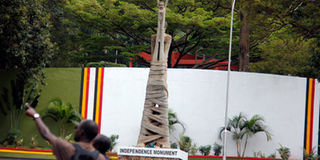History curved out in monuments

What you need to know:
Monuments remind us of many significant people or events in our history. We look at some of the monuments in Uganda and why they were erected.
They come in different shapes, sizes, and importance but we cherish them and in more developed societies, they are protected and revered. Monuments not only add beauty and colour to a place, they are wonderful landmarks that say a lot about the community and its heritage.
Monuments are structures specifically created to commemorate either a person or an event, to remember a historical incidence related to either that person or that event. The word “Monument” comes from a Latin word monere, meaning to “remind” or “to advise”.
World over, there are iconic monuments such as the Egyptian Pyramids, the Great Wall of China, The Eiffel Tower in Paris, Taj Mahal in India, the Statue of Liberty in America, among others.
Back home in the once city of Seven hills (now more than 12 hills), Kampala, there are monuments of both historical importance and personal monuments that have either been paid little attention to or that we have looked at with little appreciation, much as they are easy to reach.
According to Fredrick Nsibambi, a heritage consultant with The Cross-Cultural Foundation of Uganda, monuments are important in varying ways. “Monuments are reference points of our history and culture, memorial sites and they also have economic reasons.”
Nsibambi lists a number of monuments that have become a source of revenue in their respective localities such as Fort Lugard at Patiko, Dufile fort, among others.
The Independence Monument
Standing at about six metres tall, unveiled on October 5, 1962, just four days before independence by then Prime Minister Sir Apolo Milton Obote. The monument was part of the celebrations to mark the country’s independence.
Built by Gregory Magoba, one of Uganda’s first professional sculptors, the monument is located almost at the head of the capital’s hotels triangle area, between the Sheraton Kampala Hotel, Grand Imperial Hotel and Standard Chartered Bank.
This piece of art depicts a man unwrapping and raising the child to touch the sky, signifying the birth of a new free nation from colonialism and bondage.
The Stride Monument
Built in memory of the hosting of the Commonwealth Heads of Government, (CHOGM) in 2007, it is about a kilometre away but still within the Hotels Triangle, just behind the Parliament and in front of Kampala Serena Hotel. The monument, which shows a man and woman with a child, probably a family moving forward, signifying that the commonwealth countries are developing together as a family, was unveiled by the Queen of England Elizabeth II during the CHOGM summit.
The Stride Monument was built by 11 professional sculptors headed by Prof George Kyeyune.
The Centenary Monument
As part of its centenary celebrations, Kampala City Council unveiled the Centenary Monument located within the Centenary Park in Kampala. The 6ft monument of a treadmill protected by shields, signifies progress.
The monument, which also features on the twenty thousand shillingnote, was designed by Sylvia Katende from Makerere University.
Education monuments
Most Education centres across the country have a monument of some sort within their compounds. The most outstanding education monument is at Kyambogo University, depicting three children striving to touch a book (in picture).
The monument, unveiled in 1996 by the then Prime Minister Kintu Musoke, was in celebration of 100 years of education in Uganda. This is backed up by another monument though not of the same magnitude at teacher’s house on Bombo Road of a woman raising a book.
World War Memorial Monument
It is Kampala’s oldest monument built in 1945 by the protectorate government. Located close to the High Court within the Constitutional Square, the World War Memorial Monument was built in memory of the Ugandan soldiers who died during World War I and II. The same monument is featured on the back of a Five thousand shilling note, which came into circulation in 2010.
Other Monuments
The Statue of Leadership. Located at the corner of Amber House on Kampala Road, the monument is a celebration of one man’s effort to have electricity in the country. The statue of Sir Apollo Michael Kawalya Kaggwa, one of the regents of Buganda is in commemoration of an individual who served his kingdom and had an everlasting impact on his country. It was Kaggwa who requested the then colonial Secretary in Britain Jones Crouch to have electricity and piped water introduced in Buganda.
Masaka Cathedral. In Kitovu village, Masaka District sits the famous Masaka Cathedral, which was the first African Catholic community independent African Church. The cathedral, which was designed and built by brother Flora Martin in 1927, was the official cathedral for the first African Catholic Bishop from the Sub-Sahara Africa.
Dufile Fort. Probably the oldest monument in Uganda, the Dufile Fort in Mayo District of West Nile region is said to have been built in the 19th Century. The fort was built on the site of the Battle of Dufile, which happened on November 28, 1888, between the Mahdist forces and forces loyal to Egypt. The fort was built between 1874 and 1879 for Charles Gordon, the British governor. It currently has a cultural centre, which displays the lifestyle of the Madi people through the years, and the famous battlefield.




